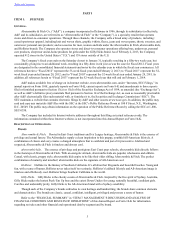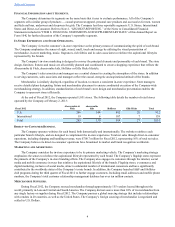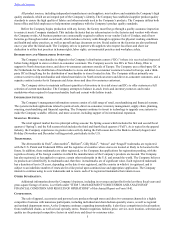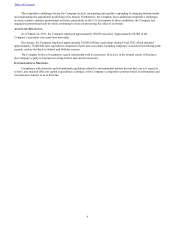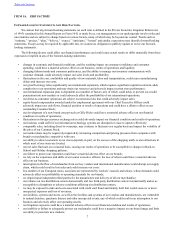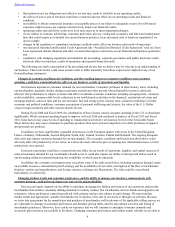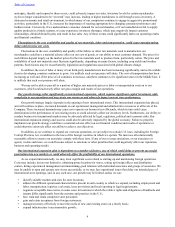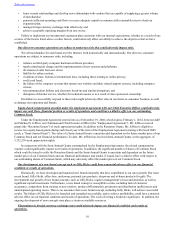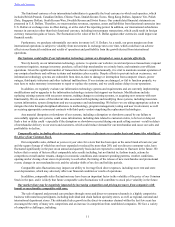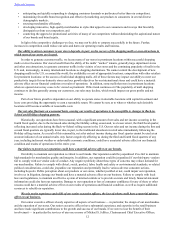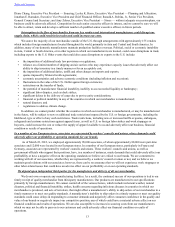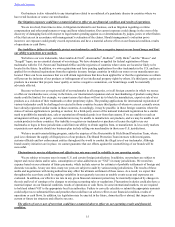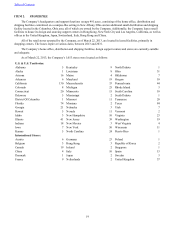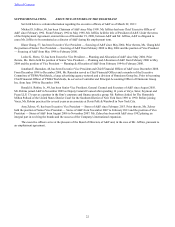Abercrombie & Fitch 2013 Annual Report Download - page 13
Download and view the complete annual report
Please find page 13 of the 2013 Abercrombie & Fitch annual report below. You can navigate through the pages in the report by either clicking on the pages listed below, or by using the keyword search tool below to find specific information within the annual report.
13
Diane Chang, Executive Vice President — Sourcing; Leslee K. Herro, Executive Vice President — Planning and Allocation;
Jonathan E. Ramsden, Executive Vice President and Chief Financial Officer; Ronald A. Robins, Jr., Senior Vice President,
General Counsel and Secretary; and Amy Zehrer, Executive Vice President — Stores — without adequate succession plans, our
business could be adversely affected. Competition for such senior executive officers is intense, and we cannot be sure we will
be able to attract, retain and develop a sufficient number of qualified senior executive officers in future periods.
Interruption in the flow of merchandise from our key vendors and international manufacturers could disrupt our
supply chain, which could result in lost sales and could increase our costs.
We source the majority of our merchandise outside of the U.S. through arrangements with approximately 155 vendors
which includes foreign manufacturers located throughout the world, primarily in Asia and Central and South America. In
addition, many of our domestic manufacturers maintain production facilities overseas. Political, social or economic instability
in Asia, Central or South America, or in other regions in which our manufacturers are located, could cause disruptions in trade,
including exports to the U.S. Other events that could also cause disruptions to exports to the U.S. include:
• the imposition of additional trade law provisions or regulations;
• reliance on a limited number of shipping and air carriers who may experience capacity issues that adversely affect our
ability to ship inventory in a timely manner or for an acceptable cost;
• the imposition of additional duties, tariffs and other charges on imports and exports;
• quotas imposed by bilateral textile agreements;
• economic uncertainties and adverse economic conditions (including inflation and recession);
• fluctuations in the value of the U.S. Dollar against foreign currencies;
• restrictions on the transfer of funds;
• the potential of manufacturer financial instability, inability to access needed liquidity or bankruptcy;
• significant labor disputes, such as dock strikes;
• significant delays in the delivery of cargo due to port security considerations;
• financial or political instability in any of the countries in which our merchandise is manufactured;
• natural disasters; and
• regulations to address climate change.
In addition, we cannot predict whether the countries in which our merchandise is manufactured, or may be manufactured
in the future, will be subject to new or additional trade restrictions imposed by the U.S. or foreign governments, including the
likelihood, type or effect of any such restrictions. Trade restrictions, including new or increased tariffs or quotas, embargoes,
safeguards and customs restrictions against apparel items, as well as U.S. or foreign labor strikes and work stoppages or
boycotts, could increase the cost or reduce the supply of apparel available to us and adversely affect our business, financial
condition or results of operations.
In a number of our European stores, associates are represented by workers’ councils and unions, whose demands could
adversely affect our profitability or operating standards for our brands.
As of March 22, 2013, we employed approximately 98,000 associates, of whom approximately 88,000 were part-time
associates and 12,000 were located in our European stores. In a number of our European stores, particularly in France and
Germany, associates are represented by workers' councils and unions. These workers’ councils and unions, as well as
government officials who support their positions, have, in a number of instances, made demands that could adversely affect our
profitability or have a negative effect on the operating standards we believe are critical to our brands. We are committed to
working with all of our associates, whether they are represented by a workers’ council or union or not, and we believe we
maintain good relations with our associates; however, there can be no assurance that we will not experience work stoppages or
other labor-related issues that could have an adverse effect on our profitability or on our operating standards.
We depend upon independent third parties for the manufacture and delivery of all our merchandise.
We do not own or operate any manufacturing facilities. As a result, the continued success of our operations is tied to our
timely receipt of quality merchandise from third-party manufacturers. Our products are manufactured to our specifications
primarily by foreign manufacturers. We cannot control all of the various factors, which include inclement weather, natural
disasters, political and financial instability, strikes, health concerns regarding infectious diseases in countries in which our
merchandise is produced, and acts of terrorism, that might affect a manufacturer’s ability to ship orders of our merchandise in a
timely manner or to meet our quality standards. A manufacturer’s inability to ship orders in a timely manner or meet our quality
standards could cause delays in responding to consumer demands and negatively affect consumer confidence in the quality and
value of our brands or negatively impact our competitive position, any of which could have a material adverse effect on our
financial condition and results of operations. We are also susceptible to increases in sourcing costs from our manufacturers
which we may not be able to pass on to our customers and could adversely affect our financial condition or results of
operations.
Table of Contents


